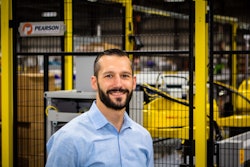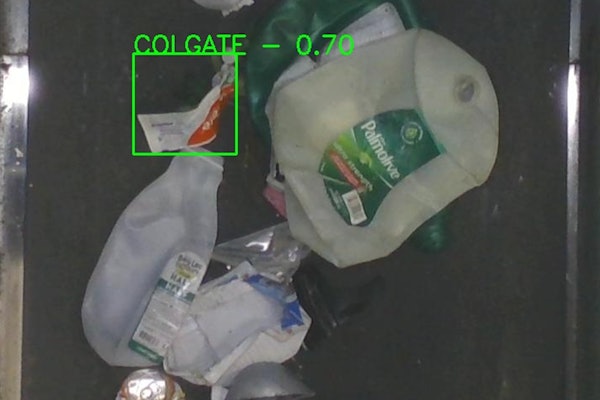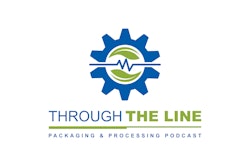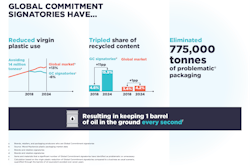OEM Magazine Editor-in-Chief Stephanie Neil sits down with former packaging industry veteran Jill Miller to talk about her role as president of Below the Line. Miller’s organization aims to move employees and their communities from economic survival to sustainable prosperity and its first step is to address the gender and racial wealth gap in the food and beverage packaging and processing industry.
To subscribe, rate, review and find more unPACKED podcast episodes, visit pmmi.org/podcast or find us on Apple podcasts, Spotify or iHeart Radio.
 | Read the full transcript below |
Stephanie:
Jill, welcome to the podcast today, and thank you so much for taking the time to talk about a really important issue.
Jill:
Hi Stephanie, thank you so much for having me. I really appreciate it.
Stephanie:
Well, before we start talking about Below the Line, a company that you started, I wanted to talk a little bit about your background. So what is your experience in the manufacturing industry, Jill?
Jill:
So, my career began a little over 20 years ago, in engineered thermoplastics for the automotive and electrical electronics market. And in 2006, I serendipitously made my way to packaging and processing. I was with a company in the beginning, called Monitoring Technology, and some of the old timers and seasoned folks in our industry will remember the product 20/20 Hindsight. It was a high-speed camera, specifically developed to troubleshoot packaging and process lines.
Jill:
So, just a little background. This is pre-iPhone and pre-cameras allowed in plants. And at the time, a lot of CPGs were going through this journey of world class OEE and reliability. And the Hindsight became an indispensable tool. What it gave me was this interesting insight into the industry, because we were able to walk in and help people see indisputably, what was going on in a downtime event or a jam.
Jill:
And what was so important about that to me, was sitting in rooms with suppliers, whether it was equipment suppliers in packaging and consumables, and CPGs at all levels of their organizations; and they worked on solutions together. And I was afforded what I think is a really unique insight into what pain looked like to a plant and a supplier and an industry, and how we collectively worked together on these issues to elevate the industry overall.
Jill:
So that was a really exciting time, as I was like a young buck in the industry. And then from there, I went on to work for a packaging equipment OEM; and did take some time off, a few years unexpectedly, because of an injury and an ill illness. And then, I spent a little time with my two amazing daughters. And when I returned in 2018, I moved over to the processing side; and I did that intentionally, as a mom and a consumer. Food safety became very important to me, and I wanted to be part of helping to deliver safe, high quality product to the store shelves.
Stephanie:
So it sounds like you've already done a lot of exploring of the issues that are happening in the industry. Tell me now what Below the Line is, and what inspired you to start this company?
Jill:
Yes. Below the Line's mission is to move employees and their communities from economic survival to sustainable prosperity. And our vision is to do this by addressing the racial wealth gap in the food and beverage packaging and processing industry.
Jill:
We have two prongs as an organization. One is as an independent, private equity sponsor that acquires companies and converts them to employee ownership. We'll talk about that more in-depth. And then the other is rooted in staffing and workforce development, education through mentoring and partnerships, to bring able workers of color who may suffer from a variety of generational traumas, and bring them into the workforce, ultimately seeding their families for wealth. So we're going to be working more on that in 2022.
Stephanie:
So you mentioned part of it being an independent, private equity sponsor. What does that mean?
Jill:
Yeah. It's a good question. It was a new term to me, six or seven months ago. So, I'll give you a little more background on how we ended up where we're at. So, after coming back to the industry in 2018, I had this discomfort, right, that I hadn't felt previously. And I really thought it was around being female, and the mother of two girls, in a commonly male industry. To some extent it was; I started getting involved in some of the packaging and processing women's leadership network events, sought out some mentors.
Jill:
But then 2020 and '21 came, and really posed more challenges simultaneously in my life than I'd ever possible. And between COVID and personal loss and some tragedy, all these things chipped away at me; but ultimately, the racial justice conversation emerged for me in a way I had not expected. I am not ashamed to admit that some nights I would get home or shut my laptop and cry, because I didn't know what to do about it. And I realized I was part of the problem, and I continued to contribute to it with my own actions.
Jill:
So, in wondering how to act really, as an ally to people of color, I started just sitting with that, right? And when we had another tragedy in our family earlier this year, I realized I wasn't coping well, or really in the healthiest of ways. And I was just done with all these things inside me that wanted me to do something different. So I decided to receive all of those challenges as a gift, and slowed down to reflect and figure out what was really important.
Jill:
So my first inclination was to leave the industry. And like many women do, I walked for a few minutes, and then I decided social work was not the place where I belonged. I got clarity on the best way to use my privilege and my ability to connect with people, and have hard conversations, by looking at some of this wealth gap inside the food industry.
Jill:
That's how Below the Line was born. And what an independent sponsor is, we have essentially, an advisory board and a couple of partners that are diverse, know the industry inside and out. And what we bring to the table that's unique, is we care deeply about the industry. We care deeply that companies we acquire are turned over to the employees for wealth gap, but still maintain the found founder of that original company's legacy.
Jill:
And then we do that with ready capital that's able to be deployed, which is funding to purchase acquisition targets. So essentially, I'm quarterbacking the purchase of a company in this industry. And then we'll go in, and be the leadership team that immediately begins the transition to employee ownership. And then after a period of time, the independent sponsor and the operational partners will exit, and leave the company in the hands of the employees and those that have emerged as the minority leadership team.
Stephanie:
Okay. So two follow-up questions to that.
Jill:
Sure.
Stephanie:
Are there certain qualities to a company that you are targeting to acquire?
Jill:
Yes. So we're looking at companies in the packaging and processing space, probably an equipment supplier, one that is closely held, or a family-owned business. The size of it would be $1 million plus in EBITDA; and I think if anybody's looking to sell they'll understand what that means. 40-plus employees, with at least one-third being people of color, and moving from there. Once we would acquire the company, then we would begin to transition the ownership. We're not completely worried about what the leadership looks like today. The idea is, that we have a pool of enough employees that are people of color, that we can start shifting the wealth gap for them and their families.
Stephanie:
Okay. So the second part of my question is then, you identify this company. What happens in terms of preparing the company to be employee owned? You talked about staffing and workforce development. Is there a particular hands-on approach that you go in there with, to grow the organization with more people of color, or more diversity? Or what happens after the acquisition?
Jill:
Yeah, that's a really good question. And I think that's where all the fun work begins, and really hard work, too. So part of the advisory board even that we put together, is people of color from places like the West Side of Chicago, or the South Side of Chicago. But there are also people who are doing a lot of work around industrial organizational psychology, and mentoring emerging leaders in people of color populations.
Jill:
So, we would go in, purchase the company, work with the owner to make sure we're honoring their legacy, while trying to meet investment goals, and start creating a culture. We talk a lot, even in our own meetings, about culture, and how we want that to look. And some of it I've had to hold and say, "Until we know what we're buying, we can't completely define how all this looks." But what we do know, is that a lot of people need things like hope and optimism and resilience and efficacy. And we need to deal with the fact that some people may not be emerging as leaders when they are people of color, because there is generational trauma that's been overlooked, or there's been violence, or there's anxiety, and they're not feeling psychologically safe in an organization, and that's them back.
Jill:
So, we need to look at all of those things as we unfold this. It's going to take time. And I think that the transition's going to be about five years. And then from the financial scaffolding piece of that, there is a plan in place to take the funding, the acquisition; there will be a transition to a fund. It's a little different approach than traditional private equity, or what a lot of people call an ESOP, because it's designed specifically with wealth gap in mind. And in order to be successful, what we can't just keep doing, is what we've all been doing in business architecture for the last 200 years.
Stephanie:
Sure. So let's focus on that for one second. Why are the barriers to entry for black-owned or female-owned businesses in the CPG and packaging segment so high, do you think?
Jill:
Let me pull back for a second, because this is not a problem specific to packaging and processing. Building wealth in this country is a marathon; and I'm an educated white girl living on the North Shore of Chicago. In a marathon, I'm in mile 12; a white man of privilege, maybe in mile 23. If you take a young black man from the West Side of Chicago, he probably didn't stretch, because he didn't know to. He's on mile three or four. There are very few people left cheering him on, and he's lucky if he's got shoes. If we don't give him hope and safety and proper training, and clear the way, and maybe even a ride to mile 14, he will never catch up, let alone finish. And we feel like the partners we're working with can help us to do some of those things responsibly.
Jill:
So when you look at the industry in particular that we belong to, as that industry grew and continued to grow, after the Industrial Revolution, post World War II, for a long time, women and people of color couldn't even own these companies, and they just got further and further behind in the race. Now you have this major concentration of wealth in this country, and the capital among will just use people of color. Populations, it doesn't exist. The money isn't there to overcome the barriers. And if we continue on the current path, the gap's getting bigger, and I'm sure the data is coming out, but COVID has accelerated that.
Stephanie:
Sure. But that's a really big issue. From what I'm hearing, you want Below the Line to be sort of a catalyst for change; but can one organization do that?
Jill:
No, absolutely not. The CPGs so far are doing a great job in leading a conversation around supplier diversity. More can always be done, but equipment suppliers and some of the more custom houses aren't very diverse in their ownership, and the CPGs don't have the luxury of pressing or choosing a diverse supplier.
Jill:
So, what really drove me, and I know this is a little bit... This is a long way to answer your question, but in running through some numbers, when I stepped back, I looked at about a lot of this is estimates, but I looked at about 500 suppliers in this industry. And this is when I still thought it was about being a woman. I found less than 4% out of 500 suppliers were female-owned or led. I could not find a single black-owned equipment supplier; and I hope I'm wrong. But to me, that's appalling.
Jill:
And it's where I noted, "Oh my goodness. This is way bigger than women, right?" Because if you look at the consumer buy side of the industry, African Americans in this country have a $1.2 trillion buying power, annual. If you just take the top 10 CPGs, African Americans have spent roughly over $13 billion in the last 12 months. Classic grocery stores, if you expand it outside of the top 10, classic grocery stores, these people have spent $24 billion in the last year. And put super centers on top of that, and it's another $15 billion.
Jill:
So, roughly I think packaging and processing equipment purchases in 2020 were $10 billion. So I interpret that, in my mind, that this is what it says: "For a community that has $1.2 trillion in buying power, not a single item put in a grocery cart, or into their pantries was packaged or processed on a piece of equipment sold to the industry by a company that is black-owned. And fewer than 5% is female-owned. I only know this industry. I know it really well; but I do know is if we don't together, figure this out, we don't have a strategy to diversify the supplier base.
Stephanie:
Yeah. And those numbers are pretty powerful. So, when you talk about doing something together, how can we get our industry, packaging and processing, to unite?
Jill:
Yeah. So I think we're one facet of that, right? We provide a model for exiting owners and founders to transition their companies to employees, while they meet their retirement needs, and leave a legacy that can last generations. It might not be the legacy to their children they thought it would be, but it preserves and strengthens relationships with other suppliers and CPGs. And it allows more families to benefit from that wealth than just their own.
Jill:
As an industry, we need to continue to shift our business architecture, to collaborating common ground, elevating one another, and have the hard conversations. So, from my perspective, the CPGs can financially support the work of companies like Below the Line right now, with either a planning grant, or critical launch funding gifts, making space and resources available. I figured out I needed to get this done, and I have made the biggest bet I have ever made, by staking my life savings and my kids' college funds on this. Because until we acquire the first company and are successful, I'm funding this out of my own pocket.
Jill:
And I know there's a lot of desire to look at this. Owners who are looking to exit, should start opening up to the possibility of employee ownership, and get educated about it, and look at it as a realistic option for transition. The MMI can certainly help editorially continue to help us look at the big picture, and gather the data associated with this.
Jill:
Packaging and Process Women's Leadership Network has been great. My ask to every single woman there has been answered, and I am deeply grateful for that. So there's a lot of ways. I'm talking with some CPGs already about how Below the Line fits into their diversity, equity, and inclusion initiative, and promises how things like this enhance sustainability, and feed into social impact initiatives, such as breaking the poverty cycle, and bringing food to hungry mouths. There are a few that we're going to be hopefully announcing some relationships with in support, in the next three to six months, so I'm really excited about that. But I'm kind of an open book. If people want to talk about this, I can talk all day, to bring you awareness.
Stephanie:
Yeah, well, that's good. Well, speaking of talking, I heard that you recently met with Lori Lightfoot, the Mayor of Chicago. Is there any in insight you can provide to our listeners on what that conversation was?
Jill:
Yeah. Her office is doing a lot around addressing wealth gap. But her team is really committed to, and engaged in addressing this. I think they see that you can't go at it with the traditional methods. And I saw her this weekend actually, at the Chicago Upside Down Halloween Parade, but I did get the chance again, to talk with the mayor and some of her staffers about the programs around wealth gap that have components that are not only Chicago-based, but they also have very deep roots to the food and beverage industry, nationally.
Jill:
And I think we just all need to keep collaborating and working together. So, in terms of widespread support, we're going to continue that conversation, because I think this is again, another right intersection of business and government. We have to look at minority business enterprise status. Technically, a lot of employee-owned companies don't qualify for MBE, even if 100% of the employees are minorities. So we need to start addressing those things, because the scaffolding for how we move this forward isn't set up in all these areas.
Stephanie:
So you might start in Chicago area, but you do foresee this having a widespread...?
Jill:
Yeah. Yeah. I would love to purchase a company in Chicago; but if it's not Chicago, we'll go where we need to go to do the work, right? I think it will happen, but we're open to anything inside the US borders.
Stephanie:
So, you did talk a lot about why this is so personally important to you Jill. As we sort of wrap up this conversation, and we talk about the next steps for Below the Line. Is there anything else you, in sort of messaging, what you want to make sure our listeners understand about what will Below the Line is, the mission, and what the plan is for 2022?
Jill:
Yeah. Great question. So I think in terms of the personal importance, I don't think I can wrap that up in anywhere near 20 minutes. But I just could not continue to know that people were being hurt and starving and dying in our communities, and I was contributing to the problem. I just couldn't un-see it anymore.
Jill:
So, 2022 is going to be a really exciting year. We are going full steam on working with established and emerging thought leaders in the industry on racial wealth gap, and how we step forward together. I have a really wonderful and diverse group of partners and advisory board, industry and non-industry people who are pledged to breaking down barriers for people of color in this industry.
Jill:
We are also, hopefully, going to be announcing our operational partner, which will be very exciting. We were very selective on the criteria around who we want funding this acquisition, and that they had the same goals and values that we do. I am 24/7 listening for whispers in the wind, and hopefully finding the OEM that trusts us enough to give us the privilege of transitioning their life's work into the hands of the employees.
Jill:
We are certainly going to keep learning, because when days go by that I'm not failing at this, or learning something in it, I feel like I'm not working hard enough. We're hoping to expand and scale on the workforce staffing side and emerging leader development.
Jill:
And then finally, again, we're trying to make ourselves available to the industry as a resource in this journey. We want to work to close this gap together. I'm very easy to find. I'm easy to engage with. And I really enjoy going deeper on this topic, and listening to the other hundred thousand voices in it.
Stephanie:
Well, Jill, I applaud your efforts, and I wish you so much success, going forward. And we will do what we can to support your very important work. Thank you so much for sharing your story with us today.
Jill:
Thank you, Stephanie. It was great to talk.

























